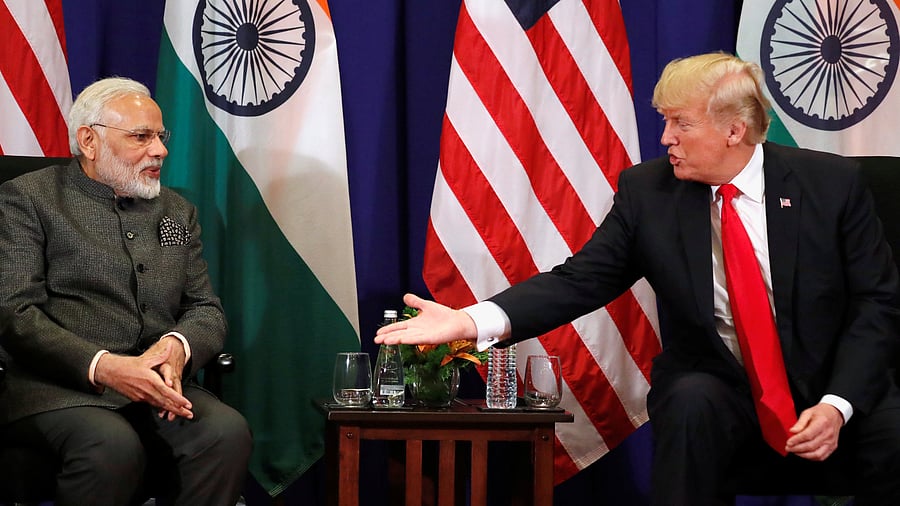
PM Narendra Modi (L) and US President Donald Trump (R).
Credit: Reuters File Photo
By Andy Mukherjee
President Donald Trump has put the Indian prime minister in a tight corner. The 25 per cent tariff that he says he’ll impose on US imports from the most-populous nation isn’t significantly higher than the rates he has announced for Southeast Asian countries like Vietnam, Indonesia and the Philippines. But there is a catch: a penalty that will punish New Delhi for its “most strenuous and obnoxious” non-tariff barriers — and for buying Russian military equipment and energy.
The quantum of the retribution was not specified in the president’s Truth Social post, even though the new tariffs are scheduled to come into force from Friday. Therefore, my first reaction is that it’s a bluff — a bargaining tactic. Trump wants last-minute sweeteners thrown into whatever trade deal Narendra Modi’s negotiators have put on the table.
Trouble is, any concession to dodge the blow will give ammunition to Modi’s opponents. Trump has repeatedly said that he brokered a ceasefire in the recent India-Pakistan military standoff by offering trade deals to the nuclear-armed neighbors. That’s embarrassing for New Delhi; its long-time policy has been to reject any international interference in disputes with Islamabad. Just this week, the leader of the opposition, Rahul Gandhi, dared Modi and his ministers in parliament: “If he has the courage … let them say here that ‘Donald Trump, you are a liar.’”
It’s been four months since Trump’s “Liberation Day” package. The deals he has announced since then have, with the exception of China, generally seen a reduction from the reciprocal rates he announced April 2. Vietnam got its 46 per cent tariff slashed to 20 per cent; Indonesia saw its 32 per cent tax cut to 19 per cent. The European Union and Japan, too, managed to get some discounts.
In India’s case, however, even assuming a modest 5 per cent penalty for alleged bad behavior, the original sticker rate of 26 per cent will go up to 30 per cent. Taken together with the US claim on the ceasefire, it’s a big wound to national pride. For the US leader, however, threats and inducements are a source of leverage. “Pakistan and the United States will work together on developing their massive Oil Reserves,” Trump wrote on social media on Wednesday. “We are in the process of choosing the Oil Company that will lead this Partnership. Who knows, maybe they’ll be selling oil to India some day.”
So what more can Modi offer to appease Trump without suffering a further dent to his strongman image at home? He can safely junk the elaborate certification regime his government has put up in recent years to check the quality of everything from the imported polyester in Nike gym shorts to the metallic water bottles on sale at Amazon.com Inc.’s local marketplace. Those restrictions — a reprising of its old socialist-style “Inspector Raj” — claim to protect consumers from inferior goods. In reality, they only serve the interest of local tycoons.
Similarly, it won’t hurt to allow genetically modified variants of corn and soybean, the two biggest American farm exports by volume. India’s own agriculture is ripe for reform: It’s time to follow China’s lead and start giving farmers the freedom to grow GM food. But Modi has to hold the line on dairy imports and biofuels. Washington will have to accept that the milk, butter and cheese sold in India can only come from animals that have not consumed feeds containing “internal organs, blood meal, or tissues of ruminant or porcine origin.” No Indian government can afford to sacrifice a core cultural value of the nation’s vegetarian population.
Nor will local motorists welcome American biofuels. Some are already worried about the engine life of their vehicles after recent media reports suggested that the Modi government might raise its existing mandate of mixing 20 per cent bio-ethanol in gasoline to 27 per cent. This blending is meant to reduce India’s dependence on Middle Eastern crude oil, and for local farmers to get an additional revenue stream for their corn, broken rice, rotten potatoes, sugarcane and molasses. If corn grown in Indiana starts competing, the whole point of the program will be lost.
As for where 1.4 billion people should source their energy, crude oil shipments coming from Russian ports averaged about 1.3 million barrels a day last week, down from 2.1 million barrels at their peak in May 2023. Ending these imports abruptly is bound to raise pump prices and reignite inflation that has been subdued with nearly three years of high interest rates.
Here, however, it’s possible to do a deal. Trump signed off his post on Indian tariffs with his favorite rallying cry: “MAGA!” American natural gas would be too expensive for India, but a component of it — ethane — is just right for Mukesh Ambani. Asia’s richest business czar has spent the past decade preparing to import more US ethane to feed his petrochemicals empire. As I have argued before, he’s someone who can play a part in making America great again.